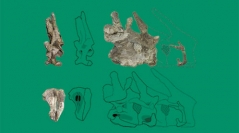

 Comptes Rendus Palevol
21 (45) - Pages 991-1019
Comptes Rendus Palevol
21 (45) - Pages 991-1019The osteology of Pilmatueia faundezi Coria, Windholz, Ortega & Currie, 2019, a dicraeosaurid sauropod from the Lower Cretaceous of Patagonia, is reassessed from the perspective of a new specimen (MLL-Pv-010) that provides additional information on the axial skeleton and the pectoral girdle. The specimen MLL-Pv-010 is composed of three articulated anterior-middle cervical vertebrae (with their respective ribs in position and an associated fourth rib), seven dorsal vertebrae with associated dorsal ribs, a distal caudal vertebra, a left scapula and the proximal end of a right scapula. The new specimen shows features, especially in the middle cervical vertebrae, that link it to Pilmatueia faundezi. Additionally, the specimen MLL-Pv-010 shows features previously unknown for the species, such as the morphology and orientation of the bifid neural spines of the anterior and mid-cervical vertebrae. The information obtained from the specimen MLL-Pv-010 allows us to propose an expanded diagnosis of Pilmatueia faundezi. Moreover, two phylogenetic analyses focusing on South American dicraeosaurids show that Pilmatueia Coria, Windholz, Ortega & Currie, 2019 is well nested within Dicraeosauridae Huene, 1927. One of our phylogenetic hypotheses differs from previous contributions in showing South American dicraeosaurids as a monophyletic group. However, in the second hypothesis these are not recovered as a natural group. We think that it is reasonable to recover a South American dicraeosaurid clade, and that eventually it will be best supported once more evidence is recovered.
Sauropoda, Dicraeosauridae, Pilmatueia faundezi, Lower Cretaceous, Mulichinco Formation, new specimen